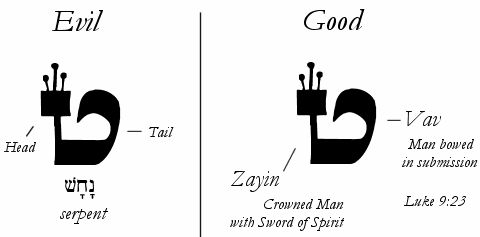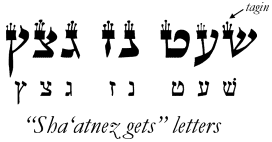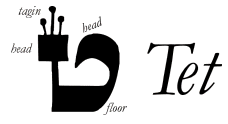|
The letter Tet is the ninth letter of the Aleph-Bet, having the numeric value of nine. The pictograph for Tet looks like a snake coiled inside a basket, whereas the classical Hebrew script is constructed of two preceding letters, Vav and Zayin, also joined and somewhat resembling a snake:

- The Mystery of Tet
Tet is a paradoxical letter in that it reveals both good  (tov) and evil. The form of the letter is "inverted," suggesting hidden goodness, like that of a woman who is pregnant with child. However, sometimes the potential for goodness (tov) and evil. The form of the letter is "inverted," suggesting hidden goodness, like that of a woman who is pregnant with child. However, sometimes the potential for goodness  (tahorah) is perverted, and impurity or filth (tahorah) is perverted, and impurity or filth  (tumah) results. (tumah) results.
Tet is the least frequently occurring letter in the Scriptures (Yod is the most popular). The letter first appears in Genesis 1:4:

"And God saw the light, that it was good: and God divided the light from the darkness."
But note even here that there is a sort of paradox. God saw that the light was good, but God separated the light from the darkness, thereby making a distinction.
- Tet and the Mystery of Evil
God is the source of all that is good in the universe:

"Give thanks to the LORD of Hosts for He is good..." (Jer. 33:11).
Yet even though God is categorically good, since He is the ultimate reality and Creator of all, He is the One who ultimately controls the affairs of humankind, both the good and the calamitous:

"I form (yotzer) the light, and create darkness (choshekh); I make peace (shalom) and create evil (or calamity) (ra). I the LORD do all these things (Isaiah 45:7).
How the LORD uses evil in the universe for His own good purposes is a mystery, but we are assured that all that God created was good (Genesis 1:31) and that His steadfast love endures forever:

"Oh give thanks to the LORD, for he is good; for his steadfast love endures forever!" (Psalm 118:1)
Note: The Jewish blessing HaTov v'HaMativ affirms that God is good and does good, and is usually recited upon hearing good news; whereas the blessing Dayan HaEmet is usually recited upon hearing bad or tragic news.
- The Gematria of Tet
The letter Tet has the value of 9 (some Hebrew words that have this value include 
(ach), meaning brother, and  (beged), meaning garment). Using the "reduced" form of gematria, the word (beged), meaning garment). Using the "reduced" form of gematria, the word  (emet - truth) also has the value of 9: (emet - truth) also has the value of 9:

- Tet represents the two possibilities of man
The parts of Tet (Vav and Zayin) are the same as the parts for Chet, but the difference appears in the Vav, or that aspect of the letter that represents man. As we will see below, the letter Tet can picture either the man that is in rebellion before the LORD or the man that is surrendered to Him:

When a man (Vav) is bowed down before the Crowned Man (Zayin), taking upon himself His yoke (Chet), then his soul is subject to the discipline of the LORD, and the ninefold fruit of the Spirit will grow in his life (Galatians 5:22-23). This man will die to himself and all that is outside the yoke of Christ (Luke 9:23).
On the other hand, if the soul refuses to bow down and instead rebels, the inner life will take on the characteristics of the serpent (nachash), satan. If that man chooses to live for himself, relying on his own inner sense of autonomy, he will share the fate of satan and "eat dust," or the stuff of the flesh.
This principle can be seen in the story of Moses and his staff (Exodus 4:2-4). The staff represented the scepter of Moses' human authority which God asked to be "thrown down" in obedience to Him. When he did so, the carnal staff was transformed to become the spiritual staff of the LORD, even though it still contained the principle of the serpent within it (i.e., the carnal principle of his life). Later Moses sinned by using this staff in a carnal way by striking the rock twice, indicating that he attempted to retake his own autonomy instead of yielding to the will of the LORD.
In short, how the Tet will be represented depends upon our personal decision to give our lives to the Messiah and be yoked together with Him. Will we choose to surrender our lives, offering ourselves as living sacrifices, or will we inwardly rebel and live in the selfish pride that marks the devil?

"I have set before you life and death, blessing and cursing: therefore choose life..." (Deut 30:19).
- Crowned Letters
In some Torah Scrolls, eight Hebrew letters are given special adornment by attaching three "tagin" or crownlets to them. Collectively these letters are sometimes called "sha'atnezgets" letters (for Shin, Ayin, Tet, Nun, Zayin, Gimmel, and Tsade).
Midrash ascribes the origin of the tagin as part of mattan Torah - the giving of the Torah at Sinai. The Talmud describes Moses wondering about why God was seen affixing these embellishments to certain letters of the Torah:
"When Moses went up to God, he found God sitting and putting little crowns on the top of the letters of the Law. He said to God, 'Who is it that forces You to put crowns to the letters of the Law [which You have already written]? He replied, 'A man is to appear on earth after many generations, Akiba b. Joseph by name, who will expound for each top of every letter of the Law heaps and heaps of rulings'...." Talmud (Menachot 29b)

Some people have wondered if these crownlets are the "tittles" referred to by Jesus in Matthew 5:18, although it is unclear that the tagin were in use at that time. It is more likely that the "tittle" refers to the "kots" or "thorn" that projects from a letter. |














